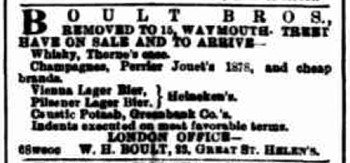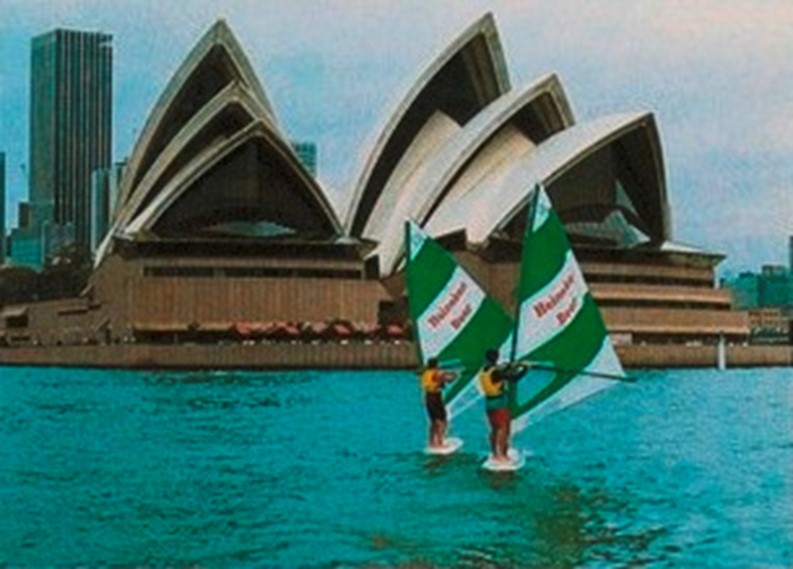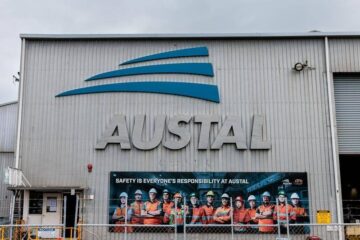Pierre van der Eng

Source: The South Australia Advertiser, 14 October 1884.
It may appear that Dutch multinational beer brewer Heineken has long tried to carry the proverbial coal to Newcastle, because its beer has been on sale in Australia since 1884. In October that year, an advertisement of trading company Boult Bros in Adelaide announced the sale of Heineken beer which it had imported from London. A month later, another company announced in a Sydney newspaper the arrival and sale of Heineken beer in port.
Since then, trading companies in Australia regularly advertised the arrival and sale of Heineken beer. In 1885, a Sydney firm advertised it as a ‘pilsener lager beer’ being ‘the lightest and best for summer’. But Heineken beer sales long remained a drop in the ocean of all the beer consumed in Australia, simply because most of it was brewed locally.
Soon after its establishment in 1864, the Heineken company in Amsterdam started exporting in other countries. And during the next 100 years it accumulated a range of international experiences through exporting, establishing joint venture breweries, and licensing the production of its beer to foreign brewing companies.
Heineken did not start to monitor its beer sales in Australia until 1949, when it experienced increasing sales across the Asia Pacific region. The catalyst for Heineken’s increasing interest in beer markets in the region was its subsidiary company Malayan Breweries Ltd in Singapore. It was established in 1931 to produce Tiger-branded beer. Due to increasing sales in the Asian region, Heineken representatives visiting the Singapore brewery regularly extended their journeys to include other countries in the region, including Australia, where they monitored beer markets and discussed maximising sales opportunities.
In Australia and other Asian countries, Heineken opted to market its product as a premium beer, in order to justify its higher price compared to local produce. A first step towards consistent marketing as a premium product was to appoint import agents.

Source: Brisbane Telegraph, 15 May 1950.
The first appointed agent for Australia was the Primrose Trading Co in Sydney, a company of the colourful Belgian migrant, wool merchant and composer Camille Clovis Gheysens. Despite Primrose’s marketing efforts in Australia, Heineken’s export data confirm that its beer sales in Australia during the 1950s and 1960s remained very modest compared to sales elsewhere in the Asia Pacific.
Reports of Heineken representatives visiting Australia explained two reasons. Firstly, imported Heineken beer remained expensive compared to local beers. For that reason, the strategy of marketing it as a premium beer to be sold in high-end outlets such as luxury hotels and bars continued.
Secondly, Australian breweries had a firm grip on the domestic market and were not interested in distributing imported beer. This left Heineken with only the choice to market bottled beer through small import companies that supplied to the luxury outlets. It was excluded from supplying pubs and regular hotels where most beer consumed in Australia was sold.
In the premium beer range, Heineken faced stiff competition from several other imported bottled beers, such as Carlsberg, Beck’s and Löwenbräu. For example, in 1975, it exported just 1,400 hectoliters to Australia, or 11% of the market for imported beer, which in turn was less than 0.1% of Australia’s total beer market.
In 1977, together with then import agent John Cawsey & Co Pty Ltd, Heineken arranged for its imported beer to be distributed via the wine and spirits distribution arm of the Tooth’s beer company in Sydney. At this time, beer sales in Australia via pubs and hotels started to decline, while sales of bottled and canned beers via bottle shops increased. Tooth’s distribution arm operated the Bottle Mart chain. This development resulted in increasing Heineken sales.
By 1982 Heineken had a 40% share in Australia’s imported beer market. But that market was still only 1% of the total beer market by volume. That year, Heineken decided on a concerted strategy to dominate not only the market for imported beer, but also the whole premium beer market in Australia. It established its own subsidiary company, Heineken Breweries Australia Pty Ltd (later renamed Heineken Australia Pty Ltd). The company took over the importation of Heineken beer, which it marketed with a zesty new publicity campaign.

Source: Heineken Contact, May 1983, p.7.
The campaign widely advertising Heineken beer as ‘Fully imported Heineken. Europe’s No.1 beer’. It also engaged in sponsoring community and high-end cultural and sporting events in Australia, such as Whitbread Race sailing, Australian Open golf, and later Melbourne Cup tennis. This increased Heineken brand awareness in Australia.
With increasing beer sales through bottle shops, Heineken’s share in Australia’s imported premium beer market increased to 50% in 1986 then to 60% in 1987, or 12% of Australia’s whole premium beer market.
Similar strategies in other parts of the Asia-Pacific region had the same effect. Malayan Breweries in Singapore started to produce Heineken-branded beer for export from Singapore, also to Australia. But its capacity was not sufficient to meet the sales potential in the region. To increase capacity, Heineken concluded licensing agreements in the region. In the late-1970s it failed to reach such an arrangement with Tooth’s failed. But it did conclude licencing agreements with the Oriental and Kirin brewing companies in respectively South Korea and Japan in the early-1980s.

By 1991, Heineken dominated the market for imported beers in Australia. Nevertheless, it opted to close its Sydney sales company and appointed Inchcape Liquor Marketing Pty Ltd as its agent for the distribution and marketing of Heineken beer in Australia. A reason was the fact that sales in Australia had grown, but were still very modest at a time when Heineken required all available hands for its global expansion through a range of acquisitions across the world.
It took until 2004 for a further significant change in Heineken’s operations in Australia, when it established a joint venture operation with Lion Nathan, then Australia’s second largest brewer: Heineken Lion Australia Pty Ltd. As part of the arrangement, Lion Nathan commenced the production of Heineken beer in license in 2005 at its Toohey’s brewery in Lidcombe. The joint venture company distributed and marketed the beer.
The sales of Heineken beer in Australia increased on the back of the diversification and expansion of Lion Nathan. In 2010 Lion Nathan expanded the capacity of Toohey’s brewery to increase the production of Heineken beer by 45%. Lion Nathan acquired several other beverage companies in Australia and New Zealand, as well as the licenses to brew under a range of other beer brand names. As a consequence, Lion Nathan rivalled Carlton & United Breweries in dominating Australia’s market for alcoholic beverages.
Secure in the knowledge that their cooperation had established Heineken beer’s market share in Australia, both companies in 2017 replaced their joint venture with a new licensing agreement. Under the agreement, Lion Nathan brews and distributes Heineken-branded beer. The Sydney office of Heineken Asia Pacific Pte Ltd in Singapore arranges the advertising, merchandising and publicity of Heineken beer in Australia and New Zealand.


